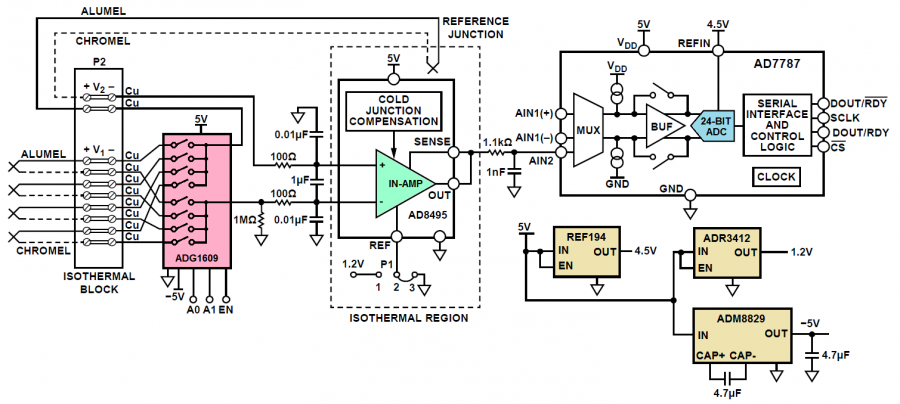
CN-0354 is a flexible, 4-channel, low power thermocouple measurement circuit with an overall power consumption of less than 8 mW. The circuit has a multiplexed front end, followed by an instrumentation amplifier that performs cold junction compensation (0°C to 50°C) and converts the thermocouple output to a voltage with a precise scale factor of 5 mV/°C. The error is less than 2°C, over a measurement range of −25°C to +400°C, and is primarily due to the thermocouple nonlinearity. A nonlinearity correction algorithim reduces the error to less than 0.5°C over a 900°C measurement range. Noise free resolution is less than 0.1°C. The signal is then digitized by a 24-bit Σ-Δ ADC, and the digital value is provided on an I2C serial interface. With the PMOD form factor for rapid prototyping, the design requires minimal PC board area and is ideal for applications that require precise thermocouple temperature measurements.
The four thermocouple inputs to the circuit are terminated at the isothermal block, P2. The ADG1609 CMOS multiplexer switches the four thermocouple channels to a single signal conditioning block to handle four thermocouple inputs.
The signal is amplified by the AD8495, a precision instrumentation amplifier that is laser trimmed to provide a precise 5°mV/°C output for a K type thermocouple. The AD8495 also provides cold junction compensation over a range of 0°C to 50°C.
The fifth thermocouple is added to cancel the voltage generated by any temperature differential that exists between the isothermal block and the AD8495 cold junction compensation circuit.
TheAD7787is a 24-bit, low noise, low power Σ-Δ ADC for low frequency measurement applications, such as thermocouple measurement systems. Its internal clock eliminates the need of an external clock to the device and makes the output data rate user configurable. This can reduce current consumption because it functions at a lower internal clock frequency. It contains a Σ-Δ ADC with one differential input and one single-ended input, either of which can be buffered or unbuffered after passing through a multiplexer.

NOTE: If not all four thermocouple channels will be used, it is recommended to short out the positive and negative terminal of any unused channel at the isothermal block P2 in order to avoid the AD8495 from railing.

NOTE: It is recommended that you install the CN-0354 Evaluation Software to the default directory path C:\Program Files\Analog Devices\CN0354\ and all National Instruments products to C:\Program Files\National Instruments\



NOTE: It is recommended that you close all other applications before clicking “Next”. This will make it possible to update relevant system files without having to reboot your computer.

It is recommended that you install the drivers to the default directory path
C:\Program Files\Analog Devices\SDP\Drivers

NOTE: Default values are provided in the System Configuration tab in order for the software to run even without specified preferences are inputted.
Everytime the temperature range is changed in the software, a corresponding change should be done in the hardware setting as well. Specifically, the P1 header should have the correct setting as showed in the display tab of the Adjust Temperature Range section of the System Configuration Tab.
The burnout currents can be enabled only when the buffer is active.
The data is exported to an Excel spreadsheet file with columns labeled accordingly.
Receive software update notifications, documentation updates, view the latest videos, and more when you register your hardware. Register to receive all these great benefits and more!